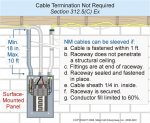- Location
- New Jersey
- Occupation
- Journeyman Electrician
What does (7) and the informational note mean when you're using a short section of raceway as a sleeve into the panel?
312.5(C) Cables. Where cable is used, each cable shall be secured
to the cabinet, cutout box, or meter socket enclosure.
Exception: Cables with entirely nonmetallic sheaths shall be permitted to
enter the top of a surface-mounted enclosure through one or more
nonflexible raceways not less than 450 mm (18 in.) and not more than
3.0 m (10 ft) in length, provided all of the following conditions are
met:
(1) Each cable is fastened within 300 mm (12 in.), measured along
the sheath, of the outer end of the raceway.
(2) The raceway extends directly above the enclosure and does not
penetrate a structural ceiling.
(3) A fitting is provided on each end of the raceway to protect the
cable(s) from abrasion and the fittings remain accessible after
installation.
(4) The raceway is sealed or plugged at the outer end using approved
means so as to prevent access to the enclosure through the race‐
way.
(5) The cable sheath is continuous through the raceway and extends
into the enclosure beyond the fitting not less than 6 mm ( 1 ∕ 4 in.).
(6) The raceway is fastened at its outer end and at other points in
accordance with the applicable article.
(7) Where installed as conduit or tubing, the cable fill does not exceed
the amount that would be permitted for complete conduit or
tubing systems by Table 1 of Chapter 9 of this Code and all appli‐
cable notes thereto. Note 2 to the tables in Chapter 9 does not
apply to this condition.
Informational Note: See Table 1 in Chapter 9, including Note 9,
for allowable cable fill in circular raceways. See 310.15(B)(3)(a)
for required ampacity reductions for multiple cables installed in
a common raceway.



